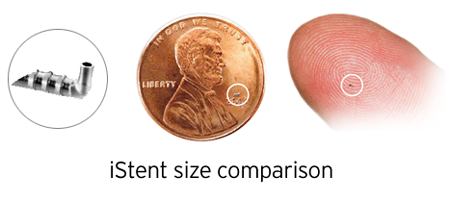Conventional Glaucoma Surgery
Conventional glaucoma surgery, or trabeculectomy, also known as filtering microsurgery, is used to reduce intraocular pressure thus preventing or lessening damage to the optic nerve due to rising pressures of glaucoma. In this procedure, a small amount of the trabecular meshwork is removed in the eye to increase outflow of aqueous. The surgeon will make a small incision in the outer part of the eye leaving a flap of tissue to cover the incision. This allows for fluid to slowly be released from the inside of the eye to its outer layers. The resulting flap creates a tiny bump known as a “bleb”. The bleb is hidden behind the eyelid therefore, it is not visible. The slow release of fluid from inside the eye allows the eye pressure to drop to normal limits, thereby lessening the detrimental effects on the optic nerve.
Trabeculectomy is performed in an outpatient ambulatory surgery setting and patients go home following the surgery. Patients are usually provided with intravenous sedation although some may require general anesthesia. Medication may also be required around the eye to prevent movement of the eye during surgery. The success rates for this type of surgery are about 70% to 90% for at least one year. Often, drugs may be required to prevent or retard closure of the bleb (drainage opening). The surgery may be repeated in the same eye if the patient’s condition warrants it.
 iStent® During Cataract Surgery
iStent® During Cataract Surgery
Designed to improve control of mild to moderate open-angle glaucoma, the iStent® is the smallest medical device ever approved by the FDA. Designed to improve your eye’s natural fluid outflow to safely lower eye pressure, iStent® creates a permanent opening in the trabecular meshwork. Proven safe and effective, the iStent Trabecular Micro-Bypass:
- Is safely implanted during cataract surgery
- Spares important eye tissue that is often damaged by traditional surgeries
- Does not limit treatment options that could help maintain your vision in the future
iStent® is placed in your eye during cataract surgery and is so small that you won’t be able to see or feel it after the procedure is over. As you can see in the picture, the device is barely visible when placed upon the penny. iStent® reduces introcular pressure (IOP) by improving aqueous humor outflow. iStent® is the only FDA-approved device for the treatment of mild to moderate open-angle glaucoma. In studies using the device at 12 months, patients who had cataract surgery alone (without iStent®) were more than twice as likely to require medication for the control of glaucoma than the iStent® group. For more information on the iStent® device click here.





